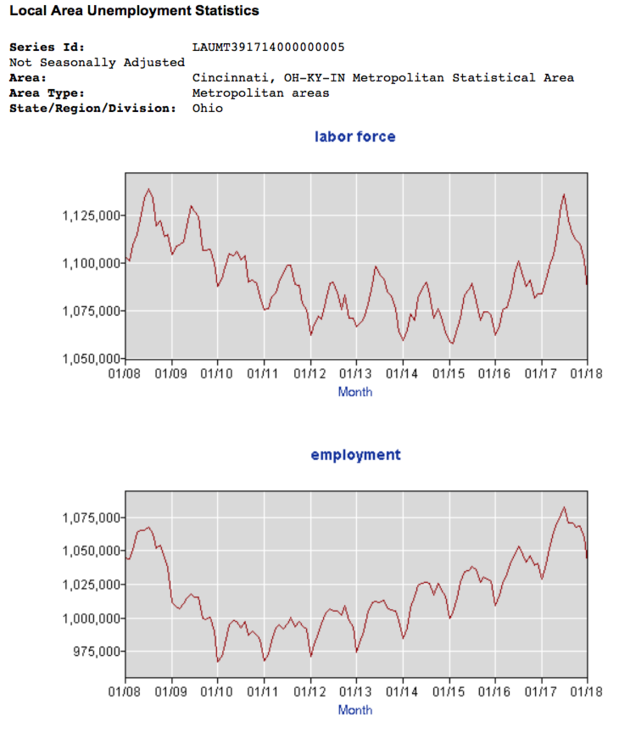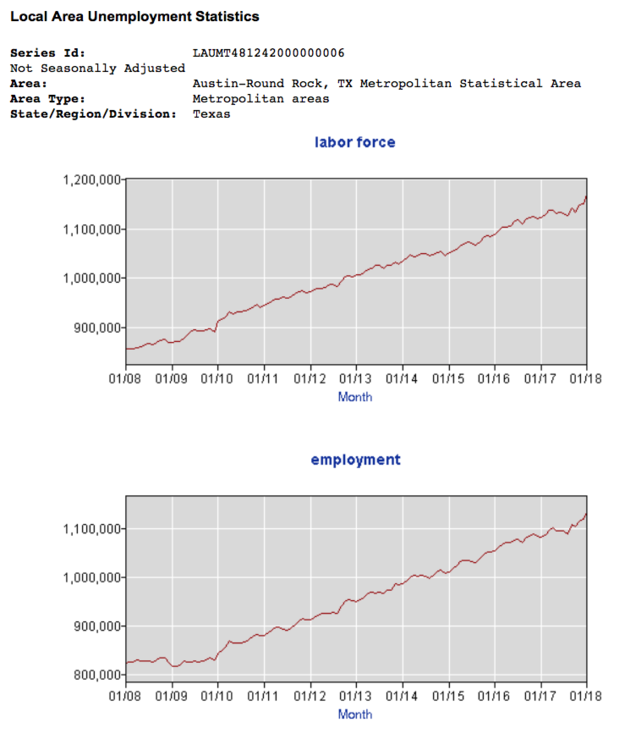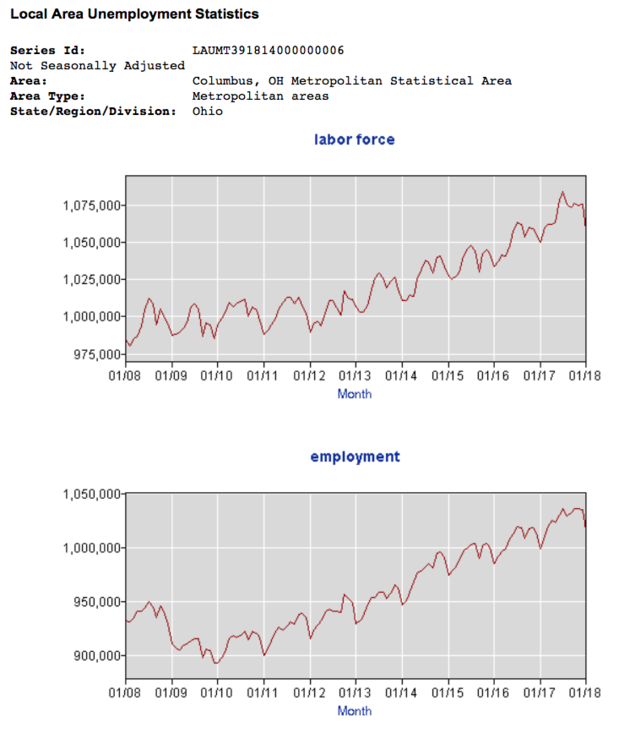Everything posted by jim uber
-
Cincinnati: Festivals, Music Concerts, & Events
jim uber replied to buildingcincinnati's post in a topic in Restaurants, Local Events, & EntertainmentCheck out the photos at the Business Courier. I don't know if its the sad state of 5th street asphalt, the cloudy day, or what, but the overall impression I got was like a second rate county fair. Rick Springfield did not help. If this were transplanted to the riverfront it would at least feel so much better. I might even go. But then, there's the naked cowboy.
-
Ohio Census / Population Trends & Lists
I'm not certain I understand the question. The place to start is something like a dot map. That's as close to "raw data" as we can get right now. (And even that assumes that we're all happy with focusing on "nighttime" population, and don't care about any differences in daytime density created by jobs, entertainment, etc.) So how do you want to define boundaries on such a map in order to define a "city" density that is meaningful? I mean, I thought that distance from city hall was brilliant, but then you have the problem of the lake! If you want to show that Columbus is more dense, then I think you can do it. If you want to show that Cincinnati is more dense, then I think you can probably do that too. It's sort of like gerrymandering - if you allow the boundaries to be anything, you can have the result that you want. The suggestion is that the numbers are wrong because places like Cincinnati have hills and other geographic/development areas that cannot have population. However, Cincinnati is only 78 square miles. Columbus is about 219, almost 3x larger. My question is how a much smaller city can have so much more no-density area than a city 3x its size, especially one like Columbus that supposedly also has many more low-density suburban neighborhoods within its borders? That wouldn't make sense. Essentially, the majority of Cincinnati would have to be devoid of people for this to work as claimed. We're talking density here. Cincinnati wouldn't have to have more non-developable area than Columbus; it would need a greater fraction of it's total land area that was non-developable. That's completely believable. I mean, you're not going to ever compare density for a land area larger than Cincinnati's of 78 sq. mi., right? So how much non-developable land is there in Cincinnati, versus any reasonable 78 sq. mi you pick in Columbus? But I guess you're rejecting my main point, which was that the scale of analysis (and the boundaries for it) matter. They might even dominate. That's why I personally get more out of things like dot maps, cause I can (sort of) let my eye estimate the different ways of calculating density, and I can see the non-dense versus denser areas, which is interesting and practical.
-
Ohio Census / Population Trends & Lists
I'm not certain I understand the question. The place to start is something like a dot map. That's as close to "raw data" as we can get right now. (And even that assumes that we're all happy with focusing on "nighttime" population, and don't care about any differences in daytime density created by jobs, entertainment, etc.) So how do you want to define boundaries on such a map in order to define a "city" density that is meaningful? I mean, I thought that distance from city hall was brilliant, but then you have the problem of the lake! If you want to show that Columbus is more dense, then I think you can do it. If you want to show that Cincinnati is more dense, then I think you can probably do that too. It's sort of like gerrymandering - if you allow the boundaries to be anything, you can have the result that you want.
-
Ohio Census / Population Trends & Lists
Hah! That's right. It's just never easy.
-
Ohio Census / Population Trends & Lists
^ Before I get too attached to it, where does this "50 sq mi" area come from? That seems waaay too big to me, as a scale of analysis. I mean, Manhattan is 23 sq. mi. -- Addition -- Maybe its best to start by looking at maps of data where there is no spatial averaging? The demographers at Virginia have done these very cool interactive 'dot maps' based on data at the census block level: https://demographics.virginia.edu/DotMap/ (unfortunately, of course, these are limited to 2010 data, currently). Here one 'dot' is one person, and their interests seem to be a lot in racial distribution, not density. I don't know how they distribute the 'dots' within a census block - or if it matters. Here's a couple of maps, both at maximum zoom scale, of Cincinnati and Columbus. From these, it seems to me that there are larger areas of higher density in Columbus in 2010 around High, compared to around downtown Cincinnati. These sorts of maps also make it pretty clear how complicated this question is of "what city is more densely populated." Which I guess is the main point.
-
Ohio Census / Population Trends & Lists
^ jonoh81[/member] I get what you are saying, and I think we all like to support our perceptions with facts. The problem is that this type of analysis is obviously sensitive to physical scale - I think that's pretty much made clear by this entire conversation. What you've done is to say "I took the numbers that are available and created some facts that are based on them." But your "facts" might not ring true if done at a different scale. I'm just making the point that we're all playing around here - you're not inherently on more solid ground just because you created a quantitative argument based on the data available (and choosing to ignore the scale) - any more than others who choose to create arguments that (they feel) are at a more appropriate scale, but lack data for quantitative support.
-
Coseau's Random Cincinnati
This section of Pike street has zero missing teeth, and overall a really high quality of buildings. Nice to see.
-
Cincinnati: Downtown: Convention Center / Hotel
That's what I've been trying to say! Change validates hotels. We can agree on tourism facts and the fact that Cincinnatians will never decide that they want to hotel. This is too funny. Keep going. The bad no-change Cincy Turing machine is going to start smoking.
-
Cincinnati: Mt. Auburn: Development and News
^ We should hire folks to drive around OTR/Mt Auburn in beaters and run into select vacant buildings.
-
Cincinnati: Random Development and News
^ In addition to these good points, I'll add that only having this ceiling look different - i.e. drywall over the joists - says very little about sound deadening. Batt insulation in the joist cavities also does very little. The sound carries from the heel strike through the subfloor and joists, and a standard ceiling just becomes a speaker for it below. Any sound deadening job that's effective can't be identified from appearance alone. It takes some measure that breaks the sound waves from traveling, so probably something like a gypcrete coating could be much more effective anyway. I remember just after I moved into an OTR condo rehab, the unit above me was rented. The sound of heels striking the wood floor was amazing. It was like they were walking in my living room. And this unit had "standard" drywall and batt insulation with new hardwood floors above. Best solution is for everyone to take off their shoes.
-
Cincinnati: West End: TQL Stadium
There is a lot of space between banning CBAs (basically what Jason Williams is arguing for) / letting developers do whatever they want, and letting Josh Spring tie us up with ridiculous requirements. If we can't have a system of government that can distinguish between genuine neighborhood concerns, and Josh Spring rants, then we just have crappy government. In my opinion the neighborhood councils are a place to go for local input, but we can not rely on them to negotiate and make critical decisions. At least, they need frameworks to work from. And professionals who are paid to facilitate. It's ridiculous to assume that any one of our neighborhood councils "speaks" for the neighborhood. Most people don't even know they exist.
-
Cincinnati Streetcar / The Connector News
yes part of it is delays - they mention both that and the valuation in the reporting. But their assumption of valuation == cost could result it, say, a 50% long term reduction in income estimate. I don't think that's out of the question at all. Whatever it is, it is stupid.
-
Cincinnati Streetcar / The Connector News
Somebody botched this pretty badly... I know the revenue here should grow over time, but this estimate was way off: Original projections for the VTICA budget line for FY 2018 was $400,000... For FY 2018, the revised projection, based on actual Auditor values and VTICA invoices, totals $36,000 resulting in a $364,000 shortfall to the Streetcar budget. Yes. It is incredible that they developed budget projections assuming that the Auditor would value buildings based on the renovation cost. It's almost as if these sorts of critical calculations are just left to some low level IT staff person who knows how to query a data base, as opposed to someone familiar with the process the Auditor actually uses.
-
Cincinnati: Restaurant News & Info
jim uber replied to The_Cincinnati_Kid's post in a topic in Restaurants, Local Events, & EntertainmentThis is all great info! Thanks for the ideas on new places to go.
-
Cincinnati: Restaurant News & Info
jim uber replied to The_Cincinnati_Kid's post in a topic in Restaurants, Local Events, & EntertainmentHmm. I usually expect to have a very hard time finding a good Chinese restaurant. I mean, the distance between eating at one of the better places in San Francisco or Chicago, and your typical Midwestern city, is huge. No? I think what I'm saying, much more bluntly, is that a typical Midwest city Chinese restaurant that I've experienced will a) Fry almost everything b) encase almost everything in either a brown glue sauce, or a white glue sauce. c) Serve rice that is the equivalent of wonder bread - almost tasteless. But I might be looking in the wrong places?
-
Cincinnati: Random Development and News
Wow I've never seen that before. I'm not an architect, but I can't understand how you can be an architect, do something like that, and then hope to get another design job.
-
Cincinnati: Over-the-Rhine: Development and News
It’s the front - these are buildings back to back one facing Wade the other the “alley”. This alley is quite visible from liberty. Plus the buildings facing Wade are very similarly designed.
-
Cincinnati: Over-the-Rhine: Development and News
If it weren't for the bizarre, fun-house style "cornices", I'd be okay with these... but I really just don't understand what's going on with the cornices. Did the Historic Conservation Board sign off on these? Here are the condos that face Wade: Yeah I was wondering the same thing about historic approval. I remember this development getting approved (of course) but it's been awhile and I can't remember the cornice details. But then again, if they looked like this, I can't imagine I wouldn't have remembered.
-
Cincinnati: West End: TQL Stadium
How many people could the line support, considering they would probably all be wanting to board around the same time? The only way the streetcar would be up to the task is if they ran all 5 of them and they created transit only lanes for game day Gotcha, I suspected as much. I took the trolley to a Chargers game once and it was not an enjoyable experience. I wouldn't give up on this so easily. First, yes the system does need to be operated efficiently as has been discussed repeatedly on the streetcar thread. But that's true anyway. This would be a terrible way to get to a game if everyone is coming at game time. But many people are going to do something beforehand, probably within walking distance, which would tend to even out the demand on streetcar service. In theory, with 5 cars running at a reliable 15 minute headway, and 267 people max capacity per car, the streetcar could transport 5340 persons/hour from the banks to Liberty and Elm. So if fan arrival was spread out over a couple of hours, you could potentially transport half of the attendees by streetcar. That's optimal of course, so maybe realistically you could do a few thousand. But that's still a significant number, not in the margins. For knowledgable fans coming from outside the basin, landing at the Banks, having dinner and drinks in OTR/WE, and ending up back at the riverfront park when weather is right, sounds pretty nice.
-
Cincinnati: Evolution and Changing Perceptions of Urban Neighborhoods
^ I'd say it shows what's possible for 1 (maybe 2) mid-size metro. And if you're not that one, then ...
-
Cincinnati: Evolution and Changing Perceptions of Urban Neighborhoods
Good to know, but I wonder about longer term trends. Cincinnati has had a net gain of 50,000 jobs since 2008 while Columbus has gained 150,000 jobs, Nashville 200,000 jobs and Austin 325,000 jobs in the same period. All are similar sized metros. My numbers are from here https://www.bls.gov/eag/. Can you imagine what Cincinnati would be like right now with an additional 100,000 jobs? Take a look at the employment graphs over that time period. Cincinnati employment took a major hit of about -70,000 over two years, Columbus only about -35,000, while Austin was essentially unfazed. The differences in these time series make Austin look, to me, like a completely different economic animal. I'm not sure it's even worth talking about a comparison of "trends", especially with only casual insight into the issues.
-
Cincinnati: Evolution and Changing Perceptions of Urban Neighborhoods
^ Gosh Matthew67[/member] I am wanting to understand your point, and I think you have one, but in the end ... I just don't.
-
Cincinnati: Evolution and Changing Perceptions of Urban Neighborhoods
^ Matthew67[/member] I'm really not sure why you think 5 years is such a long time. As someone who's rehabbed a couple of old OTR buildings, it's very hard for me to think about ever getting from the point of purchasing a property to a certificate of occupancy in less than 2 - 2-1/2 years time. I mean, you've got purchase, stabilization, design, permitting, historic board approval, historic tax credits, tax abatements + LEED (possibly), construction, ... plus possibly a couple of rounds of funding. So to get an entire blighted area with decades of disinvestment turned around in 5-10 years is only 2-5 times the time required for an individual project. It seems to me that the only way you do it faster, maybe in those cities that you mention, is you bulldoze the old stock and put up everything in large multi-unit developments that span a city block each. There's lots of people who would fight you tooth and nail on that, I think that much is obvious, and its also obvious for good reason.
-
Cincinnati: Evolution and Changing Perceptions of Urban Neighborhoods
OK this is my last gasp on this, I promise, but I do think it is relevant to development news. I wouldn't say it is quick, or easy. I have engaged the police many many times and in different ways. I have met with them. I've given them access to my property and my security cameras. They have been very helpful. Believe me, I call them. But I can tell you with absolute certainty (because the police have been very clear with me on this, and I have witnessed it firsthand), the police are not going to aggressively hunt down and hound street dealers unless they are regularly beating people up or shooting each other. There are places where that is happening, and that's where the detectives are spending their resources. It makes sense. Thankfully, we have "polite" street dealers here on Elm, and I think that is true many places. They are very aware of their impact on the local community and do not want to attract attention. Once - only once - they beat somebody up in the lot next to my house, and after they apologized to me for it! The dealers were more responsible than anyone else for getting people to stop urinating and defecating near my properties, which is REALLY bad news (I would take street dealing any day). They started actively telling the local alcoholics or junkies who used to hang out around them to avoid my properties when they had to go, after many times of my crossing the street and confronting the person who just crapped against the wall of my building. After similar many times of going outside in the middle of the night to complain about noise from the drug-dealer management (nice vehicles), who decided to stop by for a loud conversation with the dealers, they stopped that and have even adjusted their hours! Hey, I could go on and on. It's not just me, several neighbors here have done similar things. My point is, that's the "development pressure" that matters. Having the cops come by to dump out someone's beer, or write a ticket, is almost meaningless. And the dealers are not stupid - while I have witnessed countless drug deals going down (and filmed them) - I have never, not once, seen a cop find drugs on their person when they were stopped and frisked. And while I've provided film evidence to the cops and detectives, and they found that interesting, they can do nothing with it. The ONLY thing that the cops can do to put someone in jail for dealing is for under cover detectives to arrange buys and catch them in the act of selling. And like I said, they are not going to do that, unless there is gunfire or violence. The dealers know this all too well. So, things will change, and they do change. But in my opinion and experience, it's from the actions of many people like me, and of course organizations like 3CDC, who push into the neighborhoods with criminal activity, and start to see, respond, and interact. You don't just "clear out" a neighborhood, and then bring in the rehab crews.
-
Cincinnati: Evolution and Changing Perceptions of Urban Neighborhoods
Oh well I shouldn't have said that. But I've cancelled your dinner invitation anyway. Sorry. Seriously, I am amazed that you can pretend to tell me what I've been seeing with my own eyes and living with, when apparently all you've done is to send a freaked out paralegal over here every now and again. You have no idea what my neighbors and I have done, or have not done. You have no basis for even venturing a guess as to whether the problem is as bad now as 8 years ago. I, on the other hand, do, because I live here, and have played a role in that change. My whole point was that dealers, and their clients, move in response to development pressure, much easier than they move in response to police tactics, which are very limited. Thus, changes in street dealing and related patterns start with development, not the other way around. The difference between today and 8 years ago? The difference in 300 ft? Wow - both are HUGE. We used to routinely have 100 people on the streets at any one time, both sides, drinking, urinating, and deficating near my home. It was a special time. Now I don't see any of that, maybe a half dozen people at a time max, maybe a couple of dealers max. Relatively, it's a sea change. I don't think I'd do it again, but I don't regret the adventure for reasons I would never try to explain to you. By the way, you should consider changing 1400 Sycamore[/member] to your real name. It would make a difference.









